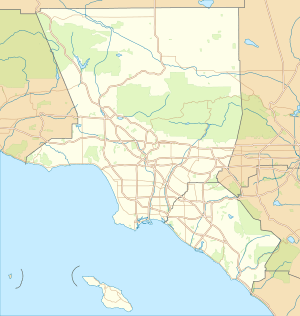Hotel Green
|
Hotel Green | |
|
| |
|
Hotel Green, 1905 | |
 Location of Castle Green in South Pasadena, Los Angeles County | |
| Location | Pasadena, California |
|---|---|
| Coordinates | 34°08′38″N 118°08′58″W / 34.14389°N 118.14944°WCoordinates: 34°08′38″N 118°08′58″W / 34.14389°N 118.14944°W |
| Built | 1893 |
| Architect | Frederick L. Roehrig |
| Architectural style | Mediterranean Revival |
| NRHP Reference # | 82002196[1] |
| CHISL # | N1062[2] |
| Significant dates | |
| Added to NRHP | March 23, 1982[1] |
| Designated CP | September 15, 1983[3] |
| Designated CHISL | March 23, 1982 |

.jpg)
The Hotel Green was in Pasadena, southern California. The hotel was built in 1893 by George Gill Green, and was later expanded by him with two additional buildings in 1898 and 1903, creating a complex of three structures. The Hotel Green was the home of the Valley Hunt Club and the Tournament of Roses association.
Hotel Green, designed by Los Angeles-based architect Frederick Roehrig in 1893, was the first of the three buildings. [4] The second building in the complex was originally known as the "Central Annex" and became known as "Castle Green." Green added a third annex in 1903, known as the "Wooster Block."
History
Construction on a hotel was initiated in 1887 by developer Edward C. Webster, between Raymond Avenue and the Santa Fe Railroad tracks. Webster built a new Santa Fe Railroad station next to his hotel site, for easy food and lodging business with trains' arrival/departure passengers. Webster went bankrupt before finishing his hotel.
George Gill Green acquired the unfinished building, doubled the size and completed the hotel in 1893. The newly expanded hotel, named the Hotel Green, opened for business in 1894.[5]
Hotel Green acquired a reputation as a luxury hotel. Pasadena historian Henry Markham Page later described it as "the first fine hotel in Pasadena". The hotel hosted society events such as receptions for significant visitors and the Valley Hunt Club's annual ball. In addition, the hotel contributed to Pasadena's economy and population. Lodgers at the hotel were credited with spending large amounts of money at Pasadena businesses, and many tourists ultimately decided to live in Pasadena.
Due to the hotel's success, Green began building an addition in 1897, and the "Central Annex" opened on January 16, 1899 to coincide with Green's birthday, and 1,000 guests came to celebrate the occasion. The new building, to become known as "Castle Green," was on a full city block but was set back from the streets, which provided open space for large new gardens. They became Pasadena's only 'public' park at the time.[5]
The hotel continued to grow in popularity with the new Central Annex. Its pedestrian bridge to the main hotel over Raymond Avenue became a popular viewing site for the Rose Parade, which ran along Raymond at the time. In 1903 Green added a third annex, known as the Wooster Block. It incorporated an earlier building constructed in 1887, which had been part of the original site of the California Institute of Technology.[5] Green planned to add a fourth annex, before running short on money for construction.
Decline
Daniel M. Linnard bought the hotel from George Gill Green in 1914. The hotel's business declined after this point, as the rise of automobile travel took away its market of Santa Fe Railroad passengers at the adjacent train station. The original 1894 Hotel Green building on the east side of Raymond Avenue was sold in 1920. By 1924 the hotel was owned by a group of investors who divided the hotel complex into three parts. The Central Annex was subdivided into fifty residential apartments and renamed the Castle Green. The Castle Green is listed on the National Register of Historic Places, the State Historic Register, and the City of Pasadena's list of Historic Places.
Half of the footbridge connecting the two buildings was demolished in 1929, and the original Hotel Green building largely met the same fate in 1935. Castle Green became an apartment complex and has been used as a film set for movies such as The Sting and "Sneakers." The Wooster Block survived the demolition but fell into disuse; it eventually became a senior citizens' home in 1972.[5]
In film
The Hotel Green is famous as the "Bodega Bay Inn" in the Puppet Master film series.
References
- 1 2 "National Register of Historic Places" (PDF). National Park Service. Department of the Interior. Retrieved 29 April 2015.
- ↑ "Hotel Green". Office of Historic Preservation. State of California. Retrieved 29 April 2015.
- ↑ "99 S RAYMOND Ave". CALIFORNIA HISTORICAL RESOURCES INVENTORY DATABASE. State of California, City of Pasadena. Retrieved 30 April 2015.
- ↑ The "Hotel Green by Frederick Roehrig" was published in the periodical The Western Architect in December 1905.
- 1 2 3 4 Gadski, Mary Ellen (March 20, 1979). "National Register of Historic Places Inventory - Nomination Form: Hotel Green" (PDF). National Park Service. Retrieved August 12, 2013. Accompanied by photos.
External links
| Wikimedia Commons has media related to Hotel Green. |
- "Official website of Castle Green". Retrieved 2008-07-08.
| ||||||||||||||||||||||||||